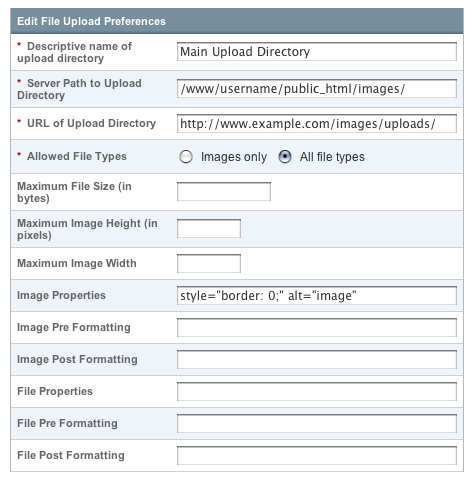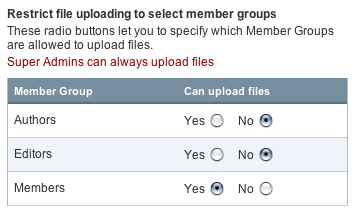Retired Documentation: You are using the documentation for version 1.7.3 which was retired in 2013. Go here for the latest version documentation or check here for your available upgrades to the latest version.
File Upload Preferences
This section of the Control Panel allows you to manage file upload destinations. These destinations determine where you can upload files when using the upload utility in the PUBLISH page. You can create as many destinations as you need in order to organize your uploaded images in the manner you wish.
Note: This utility will not create the actual destination folder on your server so you'll need to do that using your FTP program. In addition, you must set the file permissions for that folder to 777 so that ExpressionEngine will be allowed to put files into it.
Main Screen
The main File Upload Preferences page shows a list of all the existing upload destinations.

The Create a New Upload Destination tab takes you to a page where you can create a new destination, or you can click the Edit link to edit an existing destination. Either of these options will take you to the following page:
Create/Edit Upload Destination

Descriptive name of upload directory
This is the descriptive name of the upload destination. It is a required field and must be unique, but spaces are allowed. This name will appear when uploading files via the PUBLISH page.
Server Path to Upload Directory
This is the server path to the upload folder for this destination. It is recommended that you use a full server path (not a URL), although in many cases you can use a simple relative path (Example: /home/user/example.com/http_docs/images/uploads/). If you are not sure how to determine your server path please contact your hosting company.
URL of Upload Directory
You will also need to supply the full URL to the new destination (Example: http://example.com/images/uploads/).
Allowed File Types
This preference will determine how the system handles the uploaded files. You have two choices for this preference:
- Images only: With this preference set, the system will only allow image files of the type GIF, JPG, JPEG, or PNG.
- All file types: This option will allow you to upload files of any type to the system. Be careful with this setting since it could be possible for someone to upload a malicious file.
Note: Only file types that are specified in ExpressionEngine's Mime Type file are allowed to be uploaded. If you are uploading something uncommon and run into problems you may need to add the mime type for your file. The Mime Type file can be found at: system/lib/mimes.php
Maximum File Size (in bytes)
You can optionally set a maximum allowed size for uploaded file. Leave the setting blank if you do not wish to impose a limit. The size is defined in bytes; 1 kilobyte = 1024 bytes. Example: to limit each upload to 30 kilobytes, you'll put 30720 in the field.
Note: Servers usually also have built-in limits on the amount of data that can be uploaded via PHP at one time. The default value for this in PHP is 2 MB. If you have a need to upload very large files, then you should contact your Host or server admin and talk to them about any size limits they have in place.
Maximum Image Height (in pixels)
You can optionally set the maximum allowed height for uploaded images. Leave the setting blank if you do not with to impose a limit. The size is defined in pixels. This option only applies to uploaded images and not other file types.
Maximum Image Width
You can optionally set the maximum allowed width for uploaded images. Leave the setting blank if you do not with to impose a limit. The size is defined in pixels. This option only applies to uploaded images and not other file types.
Image Properties
These properties will be added inside the image tag (if an image is uploaded). Leave this setting blank if you do not wish for any properties to be added.
For example: If you have border="0" alt="image" name="image" set as your preference, when you upload an image , the resulting tag will look like this:
<img src="http://example.com/images/upload/pic.jpg" border="0" alt="image" name="image" width="124" height="98" />
File Properties
These properties will be added inside the link tag (if a file is uploaded). Leave this setting blank if you do not wish for any properties to be added.
For example: If you have title="file_name" set as your preference, when you upload a file, the resulting tag will look like this:
<a href="http://example.com/images/upload/plan.txt" title="file_name">plan.txt</a>
Image Pre Formatting
This setting lets you specify data to be placed before the HTML for an uploaded image. Using this (and the following) setting you can easily "wrap" your file code. For example, you could use <div class="thumb">.
Image Post Formatting
This setting lets you specify data to be placed after the HTML for an uploaded image. Using this (and the previous) setting you can easily "wrap" your file code. For example, you could use </div>. Together with the previous setting you would get this output:
<div class="thumb"><img src="http://example.com/images/upload/pic.jpg" border="0" alt="image" name="image" width="124" height="98" /></div>
File Pre Formatting
This setting lets you specify data to be placed before the HTML for an uploaded file (non-image). Using this (and the following) setting you can easily "wrap" your file code. For example, you could use <div class="file">.
File Post Formatting
This setting lets you specify data to be placed after the HTML for an uploaded file (non-image). Using this (and the previous) setting you can easily "wrap" your file code. For example, you could use </div>. Together with the previous setting you would get this output:
<div class="file"><a href="http://example.com/images/upload/plan.txt" >plan.txt</a></div>
Restrict file uploading to select member groups

This setting allows you to specify which member groups have permission to upload files to this file upload destination. By default, only the "Members" group and any user-created member groups are listed. Super Admins can always upload files.